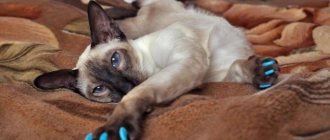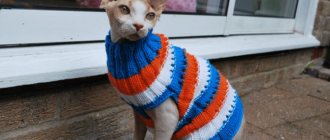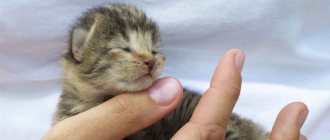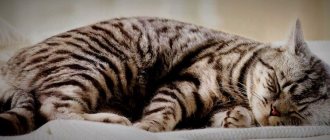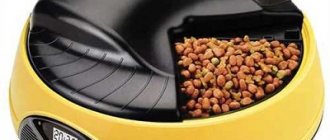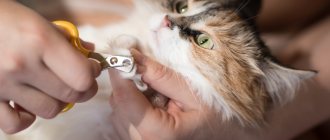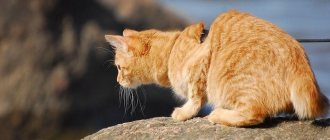Repair and decoration
06/05/2018 Anastasia Prozheva
It’s rare that a cat owner isn’t familiar with this phenomenon: it’s 5 am, and the cat outside the door is showing impatience and sometimes making very loud noises. You have to get up, open the door for your furry pet, and then wait until the latter returns home and open and close the entrance door again.
Cat door
However, this problem can be solved, especially when it comes to a private home.
Making a door for a cat with your own hands
Surely many cat owners have at least once had the idea of making a hole in the door for a cat with their own hands: either the pet makes noise at night because the door to the kitchen is closed, or the child caught a cold because the animal was accidentally locked on the loggia, and at night he entered, letting cold air into the room. To avoid such situations, there are two solutions: install a ready-made structure or make a cat door yourself.
Models of cat doors for entrance and toilet doors
Having a pet in the house imposes a number of responsibilities on the owners, which include not only providing food, veterinary care and hygiene procedures.
Felines, as bright representatives of freedom-loving animals, should be able to move freely throughout the house and go outside at any time. To make this possible without human intervention, a cat door, purchased at a pet store or made by hand, is installed in the door leaf.
Passage
There are many varieties of manholes, windows, doors and even real tunnels for cats on sale, which allow them to move freely from room to room or from home to street. The simplest passage for a cat in a door is an empty hole of the same size, not covered by a door. Naturally, manholes are not intended for installation in entrance doors; this is an “interior” option.
For additional care of the animal's coat, the opening for the cat in the door can be lined with fleecy fabric: it will act as a kind of “brush” to collect shedding fur at the moment when the pet climbs through the hole.
Such a hole in the door for cats has a significant disadvantage - if you need to isolate your pet, you will have to block the passage with furniture or other objects, which is not very aesthetically pleasing or convenient. In addition, such a hole in the door for a cat will worsen the sound insulation of the room and will allow odors to pass through (for structures leading to the kitchen or bathroom, this is a completely unsuccessful option).
Cat hole
The simplest option for arrangement is considered to be a cat hole in the door. This design is installed only in interior doors; it is rarely installed on the front door. The hole can be equipped with a special cleaning brush if desired. It will remove excess hair from the animal as it passes through it, so the house or apartment can become cleaner after installing the manhole.
This design also has its drawbacks. The most serious thing is that it will not be possible to isolate a pet in the house if necessary. To do this, you will have to block the hole in other ways, for example with furniture, which is not very convenient. Also, through such a hole, foreign odors and sounds will enter the room.
Related article: How to make a curtain on a door with your own hands
Window in the door for cats
The sash moving on a hinge is much more convenient. Although such doors cannot close hermetically and will also allow odors to pass through, the insulation will be much better. The animal will be able to pass through unhindered, pushing the sash in front of it; if necessary, the window in the door for the cat can be locked with a latch or another simple lock.
Among the disadvantages: when closing/opening, the sash can knock on the frame; it cannot be mounted in entrance structures (unreliable closure). Some animals quickly learn to unlock such a door. A folding window in a cat door is an outdated, unpopular design solution, since for the same price you can buy a full-fledged cat door, which will be equipped with many pleasant little things. But in principle it will be suitable as an interior solution.
buy a cat door
What to consider when choosing
When choosing a door for a cat, you should first decide: it will be a passage to the toilet or for other interior movements. Perhaps through the hole the pet will go out onto the loggia or onto the street. You will also have to choose the material from which the door will be made. Next, you should decide on the size and think about which type will suit you and your pet best.
If you are the owner of several purrs, then count on the most well-fed one. Add 5 cm to all parameters of the animal - this will be the size of the passage. If you don't want your sleep to be interrupted by a slamming door, don't cut a window into your bedroom door. Place such structures on the doors to the bathroom and toilet rooms.
DIY cat door
A modern mortise cat door is a very convenient and beautiful solution: wood or plastic, a large range of color options and models. Structurally, this product consists of two separate elements and a tunnel that connects both parts.
The tunnel is inserted into a cut hole in the canvas (wall), masking the cut areas. Before installing a passage in the door for a cat, it is necessary to measure the thickness of the door leaf in advance. Tunnels can be fastened together in several pieces or, on the contrary, cut, so it is not difficult to select the required size.
Doors made from treated wood or high-strength thermoplastic are wear-resistant, moisture-resistant and durable. There must be a special rim on the outer part of the sash and the frame, which allows the sash to be closed hermetically and easily - no knocking, no smells, no sounds when opening/closing. A magnet built into one of the walls holds the door in the closed position, but does not interfere with the pet’s movements (the door will not dangle in a draft or wind).
The electronic version of the door for cats has an identification reader: only a pet with a special key on its collar will be able to enter (neighbor and stray cats will not be able to visit). Flexible control system. There are 2 modes - open or closed. 4 modes - open, closed, closed for entry (the cat can leave) or closed for exit (you can enter).
Doors for cats and dogs that have a device for determining the direction of movement are extremely convenient for a country house. For example, the LED on such a door will change color when an animal enters or exits. The sensor is triggered not by the number of times, but specifically by the direction, that is, the “owner” will always know the purpose of the last use of the door, whether the pet went outside or entered the house.
What you need to consider when purchasing a door or making a passage yourself
When choosing a suitable door model, not only design features are taken into account, but also the size and physical capabilities of the animal.
The cat can't go to the toilet for a little while
The model of the device is determined by its location, functionality and materials used in manufacturing. To move the cat internally to the litter box, it is enough to install a window with a hermetically sealed flap in the door. To control the animal's entry and exit into the street, devices with a movement blocking system are used.
For your information! Closing devices in cat doors can operate in entry, exit, entry-exit and closed mode.
The dimensions of the hatch depend on the physical parameters of the animal’s body. Depending on this indicator, a hole is cut. For ordinary breeds of cats, the passage does not exceed the size of 20x20 cm, taking into account that the passage must be wider than the animal’s body by at least 5 cm on the sides and in height.
DIY cat door
If you are tormented by the question of how to make a door for a cat yourself, then you should pay attention to the products sold in stores. Some of them can be repeated yourself using inexpensive materials. For example, a flap can be attached to the top edge of a cut hole with hinges, hinges, or some other mechanism that allows the door to move in both directions.
A good door for a cat with your own hands is a fragment of transparent plastic, cut, for example, from the lid of a bucket. A wooden door is quite heavy - and there is a high probability that the cat will not open the massive door. You can use a standard latch or latch as a lock. If you put locks on each side of the door, you will get a kind of control system with the help of which you can lock the door only for the exit or only for the entrance.
We make the door ourselves
It is easy to make a cat door with your own hands. This will only require time, a little money and certain skills. First purchase plastic, sealant, latches, and a small piece of fleecy fabric.
Before you start work, check that you have everything you need at hand: jigsaw, hacksaw, drill, pencil, ruler, level, construction knife, sanding materials, screwdriver, square. A sealant will definitely be needed.
To begin, choose a location to install the door, take measurements and cut a hole. Be sure to sand the cut and decorate it.
If the door was wooden, then the remaining piece can be secured on hinges. This way you can avoid incurring unnecessary costs and wasting time. However, there is one “but”. It’s not a fact that a cat will want to push a heavy wooden door. Therefore, the best way out of the situation is lightweight plastic or hardboard glass.
To ensure a tight fit of the door, you need to install two magnets: one at the top, the other at the bottom. If you want to limit the “travel” of the animal, install a latch on the door and close it if necessary. To provide sound insulation and heat escape, attach a seal around the perimeter of the cat door.
Variety of designs
Like other door systems, doors for cats (and for dogs too) are available in a huge variety on the market today. The different models differ among themselves, first of all, in their dimensions: some holes are small and are intended for small pets, while others, which are larger in size, will be convenient for large pets, for example, large cats and dogs.
In addition, a cat door can be made of various materials:
Based on type, these designs can be divided into several groups:
Each such hatch has its own advantages and disadvantages, so the pet owner needs to weigh the pros and cons.
Features of the “manhole” design
Among the variety of cat doors, the simplest option is considered to be a manhole. Naturally, the manhole is intended for installation in interior systems (it is not mounted in entrance structures).
And yet, the hole can be equipped with a special “brush” that collects falling hairs at the moment when the pet passes through the “window”. In fact, such a hole is both a passage through the door and a portable “hair salon”.
Unfortunately, this design has its drawbacks. Perhaps its most significant disadvantage is that to isolate your pet you will have to cover the hatch with pieces of furniture; naturally, this is inconvenient, and it will also look unaesthetic. Moreover, such a hole worsens the sound and heat insulation properties of the door system (this is a bad option for a bathroom and toilet).
Types of cat doors
Mortise doors for cats are classified according to several criteria:
- type of material: wood,
- plastic,
- metal;
- product size (depending on the size of the cat);
- type of construction: manhole,
Each passage has its pros and cons, so it’s worth considering all the nuances. The door should be functional, comfortable for the animal and fit well into the interior.
Features of the manhole
A manhole is a hole without doors, made according to the size of the cat. This passage is intended for installation in interior systems. It is not installed in entrance doors and external walls.
The main advantages of the manhole:
- ease of manufacture;
- ease of installation;
- free movement of cats of any size.
The design of the manhole finishing depends on the aesthetic preferences of the owners. The passage can be a regular rectangular shape or designed in the form of an arch. Often the hole is equipped with a soft fleecy cloth or a special brush that collects shedding hair.
Sometimes the cat hole is decorated with a special brush, which combs out excess fibers from the animal’s fur.
Unfortunately, the hole has its drawbacks:
- lack of isolation of the animal. In order to temporarily lock a cat in a confined space, you will have to block the passage;
- the hole allows smells and sounds to pass through;
- Installation on entrance doors is not possible.
The open passage is suitable for cats of any size. Small kittens and representatives of large breeds will be able to easily climb into the hole without flaps. Such designs are very convenient for owners of several cats.
Characteristics of a window (sash) for a cat
A distinctive feature of a cat window is the presence of a hinged door, which is hung on hinges or hinges. A rectangular or square door opens in both directions at least 90°. A fairly light door allows the animal to move forward by pushing the door with its head. The window materials are wood, plastic, aluminum. If there is a special need, the sash closes with a simple latch. They are most often installed in interior systems.
Advantages of the window:
- retains noise and odors;
- the presence of a sash allows you to close the structure with a latch or lock;
- ease of manufacture and installation.
The most significant drawback is that when opening or closing, the door slams heavily on the frame, making loud sounds. Some cats refuse to use this design because they are afraid of the sash swinging. Some pets do not have time to tuck their tail and the closing door can pinch it. Therefore, the animal should be taught to use the window gradually. This model is not suitable for installation on entrance doors because it has poor tightness and thermal insulation, and foreign animals can enter the house through the window.
A window with a swinging sash is often used for a cat to move independently inside the house.
This design is not particularly popular because it has a number of disadvantages:
- the sash makes loud sounds that irritate the owners;
- the design is impractical for installation on the front door;
- quite high cost of the product.
It is best to purchase a window for active cats. It is better to take the window sizes with a small margin, since the cat may gain weight or become pregnant, and it will be difficult for her to fit into the tight opening.
Advantages of a mortise cat door
A mortise cat door is the most practical to use. Specialty stores offer a wide range of a wide variety of models in different colors and designs. Mortise doors are made of thermoplastic, metal or specially treated wood, so they are not afraid of moisture and temperature fluctuations. The doors consist of double-sided overhead frames, a tunnel connecting them and a plastic curtain. A rubber seal around the perimeter reliably seals the door, keeping the house warm and quiet. A magnet mounted in one of the frames returns the sash to its standard position.
Advantages of a mortise door:
- easy and silent closing and opening of the plastic curtain;
- high tightness;
- option to install a cat door in the front door or street wall;
- Some models have the ability to track the movement of the animal.
The most popular option is a tunnel and double-sided overhead frames with a transparent plastic window
The only drawback of such a product is the difficulty of making it yourself. Mortise doors are suitable for absolutely any cat.
Electronic cat door
Especially for owners who are afraid of foreign animals entering their home, they came up with electronic doors for cats. This is a type of mortise design equipped with special sensors that monitor the animal’s autonomous movement. The principle of operation is that the LED on the display changes color when the pet leaves the room. The most innovative door option is an electronic key (chip), which is placed in the cat's collar. The door will only open to an animal wearing a special collar. This system is very convenient in country houses.
The electronic door is equipped with a special device that determines the vector of the pet’s movement and does not allow foreign animals to enter the house.
All pets have individual collars, so the display on the door will be able to inform owners where each animal is currently located. The timer can be programmed for entry and exit. A significant drawback of the design is its high price. Making electronic doors for a cat with your own hands is almost impossible. Electronic doors are suitable for all cats leading an active lifestyle.
My friends who live in a country house have two Persian cats in their house. Tired of opening the door for pets one by one, the guys decided to install mortise doors for animals. We ordered a magnetic door with four modes online. The design was completely sealed and silent, and the cats mastered it quickly. But soon other people’s cats began visiting their friends’ house without permission. Sometimes my friends counted several strangers in the house. Finally, it was decided to spend money just once, but then live in comfort and not worry about the safety of your beloved pets. I had to turn to professionals and cut in a rather expensive door. But installing an electronic door has made the lives of owners and their charges much easier. Now the owners are calm about their animals, even when they are away from home for a long time.
Table: types of cat doors
| Name | description | characteristics |
| manhole | hole without flaps |
|
| window | aisle with flap |
|
| mortise door | A door consisting of a tunnel, two frames and a leaf |
|
| electronic mortise door | A door with special sensors that track the movement of the animal. |
|
Advantages and disadvantages of the window system
This type of cat door is much better insulated than a regular cat door. And besides, such a hatch provides unhindered access for pets (cats and dogs).
However, if necessary, the pet can be isolated: such a door for cats or dogs can be locked with a latch or a simple lock. The advantages of this design also include the ability to make a “window” with your own hands: even a novice craftsman can do this kind of work.
Unfortunately, when opening and closing, this cat door can make loud noises (knock on the frame), and since pets like to walk in the early morning hours, such sounds will interfere with sleep. Perhaps it is for this reason that a tilting hatch is rarely installed in interior systems.
How to do it yourself
Regardless of the chosen passage design, the DIY process begins with cutting a hole in the door leaf. In order not to violate the integrity, the hole in the door is located at a distance of 5-8 cm from the bottom edge. If the door system is paneled, then the lower element is not touched. A slot is made in the lower insert directly above it.
The canvas is removed from the box and laid on a flat surface. The square of the future hole is marked and a hole is drilled in one corner into which the blade of an electric jigsaw can freely pass. Then all that remains is to cut the material along the marks and remove the unnecessary part. At the end, the cut ends are sanded with sandpaper and coated with paint and varnish materials to protect them from damage, dirt and moisture. For decoration, you can make a frame around the cutout from slats like platbands.
If the hatch is installed in the door of the restroom, you can leave the hatch open, without any doors. However, it is necessary to take into account that the sounds of flowing water or odors will easily flow into the adjacent room, which may not be very convenient for residents.
It is very easy to install a sash in it that will open freely in different directions. The main thing is to take into account its weight so that the cat can open the door and walk through. It is best to use a piece of plastic for this or purchase any suitable product at a hardware store. A thin rubber plate or a dense piece of any fabric could be a good option.
"Pros" and "cons" of the door
A mortise cat door is convenient and beautiful. The modern market offers a huge variety of designs of this type, not only for cats, but also for dogs. The models offered to the buyer’s attention are, as a rule, made of solid wood or plastic, which means they are not afraid of exposure to moisture and temperature fluctuations. In addition, different models differ in both design and color.
Each cat door consists of two structural elements and a tunnel connecting them. The tunnel is installed in a hole made in advance in the canvas or wall, while the cut points are carefully hidden. In general, a mortise cat door should be selected taking into account the thickness of the leaf. If the leaf thickness is large, two or more tunnels can be installed, but if the sash is thin, the tunnel can be trimmed.
Each such hatch is equipped with a special “rim” that ensures proper sealing (naturally, this increases the heat and sound insulation properties of the structure) and prevents knocking when opening and closing the doors.
Usually a magnet is built into one of the walls: it is this that holds the door, preventing it from swinging open due to a draft. At the same time, pets can move freely through such a passage.
Such an access control and identification system is multifunctional: it can be two- or four-mode. In the first case, the “open” and “closed” modes operate.
Models equipped with a complex control system have four modes:
- Open.
- Closed.
- Restriction on entry (pet can leave, but cannot enter).
- Restriction on exit (the hatch will open upon entry, but the home occupant will not be able to exit).
Making your own cat door
In order to make a hatch or a regular passage for a pet with your own hands, you need to correctly calculate its dimensions. Naturally, the larger the animal, the larger the passage equipped for it will be.
Make a passage for pets, for example, dogs, as follows:
- Remove the canvas that opens the entrance to the room from its hinges and place it on a flat horizontal surface.
- A hole is cut at the bottom of the sash, the dimensions of which are determined based on the animal’s physique (for cats the entrance will be smaller, for large dogs it will be larger).
Essentially, the entrance is ready, and if you wish, you can leave the opening as it is. Such a hole will suit your pet perfectly: he will move through it without any problems.
But, unfortunately, such a hole will not look very attractive, and most home craftsmen do not stop there; they give the passage a more aesthetic appearance. Some craftsmen install hinges on the canvas and hang on them a door pre-made according to the size of the hole.
To avoid knocking when opening and closing the door, a rubber edging is attached along its edge. This DIY hatch for cats or dogs will allow your pet to move freely from room to room and will act as a barrier to unpleasant odors and extraneous sounds.
You can also make a door for cats yourself from another material, for example, plastic or chipboard. If you use all your skill and use your imagination, the entrance for your pet will turn out amazing, and besides, it will become a real decoration of the interior.
Rate this article: ( 3 votes, average score: 2.00 out of 5)
How to make a passage for pets with your own hands
Cats are very freedom-loving animals and love free movement. Installing a passage for the animal will help solve the problem of leaving the house. You can install a cat door yourself, while saving a significant amount on its purchase.
Materials for production
Tree. The frame for the manhole and the door itself are mainly made from wood.
Plastic
This is one of the cheapest materials used to make a cat hole.
Rubber
Rubber can be used to improve sound insulation. To do this, it is placed in the doorway. You can also use it to avoid loud door knocking.
Fabrics
Using fabric or other decorative decorations, you can decorate the cat's passage yourself.
Work progress
First you need to decide on the location where the passage will be installed. The best option for installing a cat door would be a wooden door system. It is the simplest and easiest to carry out any work with.
With glass or metal doors everything is much more complicated. In order to install such a structure in them, you will need to prepare for this in advance, namely, when ordering a door, ask to make a small hole in the door leaf, into which you will install the cat door yourself.
In order to carry out the work correctly, it is best to adhere to a clear action plan. This will help avoid serious mistakes that will be difficult to correct later.
First, you need to measure your pet to make a preliminary calculation so that he can comfortably leave and enter the room. The average width of the hole when making a cat door is 15-20 centimeters. Mark the resulting dimensions on the door leaf in the form of lines.
Then you need to carefully remove the door from its hinges and lay it on a flat surface. Now stores sell special templates for cutting holes. It is attached to the door using adhesive tape. The most important thing is to stick it exactly in the middle of the product. To avoid mistakes, you can use it and save your time, or act the old fashioned way: whatever is more convenient for you.
Then we drill a hole on the door leaf at the corners of the pasted template or according to our own markings. The drill bit used should be larger than the width of the jigsaw blade. During work, you must wear protective clothing and goggles, and follow the necessary safety precautions.
Mark straight lines along the edge of the hole. Then we cut out the hole itself on the door leaf; to do this, insert a jigsaw file into the hole being drilled. It is necessary to keep the jigsaw firmly pressed against the door so that it does not jerk while working. There is no need to rush, everything is done as carefully as possible. Move the jigsaw along the marked lines evenly and smoothly.
After all the cuts have been made along the marking line, we remove the unnecessary piece of the door leaf. This rectangle can later be used to make a cat door.
Next, the cut hole is finished, it is treated with sandpaper and thoroughly cleaned of dust.
A self-made or ready-made cat door is applied to the hole and checked to see if everything matches in size. It is also necessary to mark on the door leaf the place where the fasteners will be located. Using a drill, we drill holes for fasteners in all corners through and through. We insert bolts into the resulting holes and secure all four corners of the door with nuts.
There are different methods of fastening, everything will depend on the model of the selected door. At the last stage, we clean the resulting structure from dust and check its reliability and safety.
Related article: The door lock is jammed, what to do?
The hole in the interior or entrance door for your cat is ready, all you have to do is show it to your pet and teach him how to use it.

